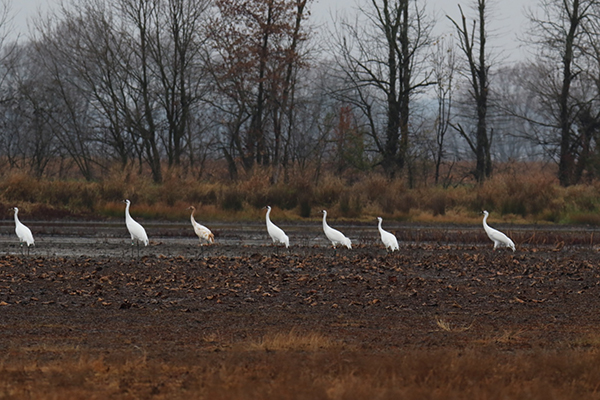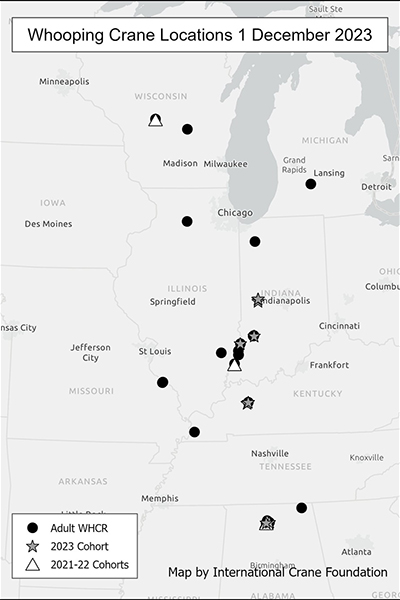
Below is the most recent update for the Eastern Migratory Population of Whooping Cranes. During November, the chicks of the 2023 cohort migrated south with other Whooping Cranes, and most cranes are gone from the breeding grounds! A huge thank you to the staff of the Fish and Wildlife Service, the Departments of Natural Resources of flyway states, the International Crane Foundation, and all the volunteers who help us keep track of the cranes throughout the year. We appreciate your contribution to the recovery of the Whooping Crane Eastern Migratory Population. The International Crane Foundation produced this report.
Population Estimate
The current estimated population size is 76 (42 F, 32 M, 2 U). Sixteen of these 76 individuals are wild-hatched, and the rest are captive-reared. To the best of our knowledge, as of 1 December, four were last reported in Wisconsin, one in Michigan (who has likely migrated south), 11 in Illinois, 27 in Indiana, six in Kentucky and 18 in Alabama. The remaining birds’ locations have not been confirmed in the last month. Their last known locations (in the past month) are on the map below. During migration, bird locations change quickly, and more may have moved further south since this report was written.

2021 and 2022 Cohorts
W2-21 (M) has migrated to Morgan County, Alabama, with W3-17 (F).
W14-21 (M) was last seen at Necedah National Wildlife Refuge with W3-20 (F) in early November.
84-21 (F) has migrated to Gibson County, Indiana, and is with other Whooping Cranes.
85-21 (M) has migrated to Morgan County, Alabama, and is hanging out with 7-11.
W1-22 (U) showed up at Wheeler National Wildlife Refuge in Morgan County, Alabama, at the end of November.
2023 Cohort
W9-23 (F) separated from 15-11, W6-18 and 15-23 during migration and arrived alone in Morgan Co, Alabama. Luckily, she’s found other Whooping Cranes at Wheeler National Wildlife Refuge!
W12-23 (M) and his parents, 24-08 and 13-02, have safely arrived in Morgan Co, Alabama.
W13-23 (U) is still with parents 12-11 and 5-11. They left Juneau Co, Wisconsin and were seen in Lawrence Co, Illinois.
15-23 (F) was parent-reared at the International Crane Foundation this summer and was released at Necedah National Wildlife Refuge in late September. She migrated to Greene Co, Indiana, with 15-11 and W6-18 in late November.
21-23 (M) and 22-23 (F) were parent-reared at the Calgary Zoo this summer and were released at Necedah in early October. They migrated to Hopkins Co, Kentucky, with 2-04 and W14-19 in late November.
16-23 (F), 17-23 (F), 18-23 (F), 19-23 (M), 20-23 (F), and 23-23 (M) were costume-reared at the International Crane Foundation this summer and were released at Horicon National Wildlife Refuge in Dodge Co, Wisconsin during October. All six have migrated and are now in Putnam Co, Indiana.
Mortality and Long-term Missing
Two adult male Whooping Cranes (28-17 and W10-15) were last seen on the breeding grounds during July and August. Their mates were then seen alone on their breeding territories and arrived on the wintering grounds without their mates. Since it is unusual for breeding pairs to separate and for one to disappear, we assume these two birds have died and are now considered long-term missing.

Story submitted by Hillary Thompson, North America Program Crane Analyst. Click here to learn more about our work in North America.
